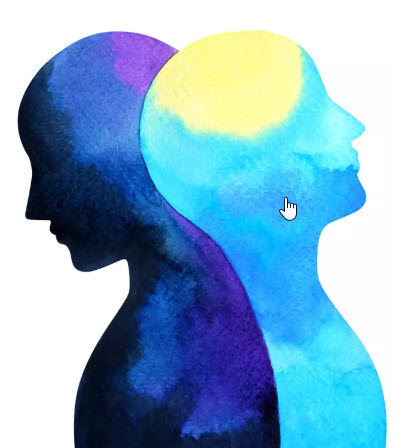
Reading Time: 12-15 Minutes
The past and present wilt—I have fill’d them, emptied them. And proceed to fill my next fold of the future.
Do I contradict myself? Very well then I contradict myself,
(I am large, I contain multitudes.)
Walt Whitman’s Song of Myself
The self is not a singular, unified entity but a dynamic system of multiple self-states. Until we grasp this concept, we will never experience a second-order change.
At first glance, the idea of multiple self-states might seem like something out of a sci-fi thriller—more Jekyll and Hyde than a serious leadership concept. But this notion is far from new. Across cultures and centuries, the idea that we contain multiple, sometimes conflicting, aspects of the self has been a cornerstone of philosophy, spirituality, and psychology. Plato’s tripartite soul and Stoic philosophy encourage reflection on competing inner voices. Taoism embraces the dual forces of Yin and Yang.
The Plains tribes, such as the Lakota (Sioux) and Blackfoot, sought their alter egos in the form of spirit animals. Hinduism speaks of the three gunas—Sattva, Rajas, and Tamas—representing different qualities of human nature. Tibetan Buddhism describes Yulpa and Yidam as manifestations of the self in meditation. Christian mystics like Teresa of Ávila and Meister Eckhart describe interior selves, and Jewish mysticism aligns aspects of the self with divine emanations. Shamans believe in channeling multiple spiritual forces. The truth is, we are not one-dimensional beings, and this concept has been known for millennia.
Freud and Jung were the most well-known theorists in psychology to identify multiple states. Freud framed the psyche as a dynamic interplay between the Id, Ego, and Superego, while Jung explored the shadow self.

However, Medical Doctors and Psychologists began documenting multiple self-states well before Freud and Jung contemplated the idea. It was mentioned in a medical journal in 1815, and the first well-documented case was in 1840. By 1880, there was evidence of multiple self-states as psychologists treated patients whose ego states lacked awareness of the others.
Later, they realized that the amnesiac barrier between the states was related to trauma. The phenomenon became part of the popular culture when Sybil became a household name in the 1970s.
When psychologists and psychiatrists realized that people like Sybil were not faking it, many made the mistake that trauma splintered the self into many states. What is clear now is that a normal phenomenon of multiple self-states became abnormal when patients created a defense that separated them with an amnesiac barrier.
Richard Schwartz normalized through the Internal Family Systems (IFS) theory in the 1980s. Schwartz, a family therapist, initially observed patterns in his clients’ inner dialogues that resembled interactions in family systems. He formally introduced IFS as a distinct therapeutic model in the early 1990s, publishing his book Internal Family Systems Therapy in 1995. Dr. Phillip Bromberg followed with his book “Standing in the Spaces” in 1999, and most psychologists now embrace the idea of multiple ego states.
The most effective coaches apply some form of the Internal Family Systems (IFS) Theory, which views the mind as consisting of multiple sub-personalities or “parts,” each with its own perspectives, emotions, and roles. IFS suggests that people have a core “Self” leading the system. However, various parts may take on specific tasks due to life experiences.
How Do Multiple Self States Work?
Imagine you had a camera at work and another at home recording your actions. Watching the feed would be psychology experts. Would they assess your conflict resolution skills similarly? Would the personality assessment match if one watched you with your friends and another with clients? Or a third saw you with your parents or family? When I ask this question, people’s first reaction is often to laugh because it is obvious–the behaviors differ significantly.
The process our mind uses to separate one state from the others is called dissociation. It is a normal psychological mechanism most people use to manage conflicting emotions, experiences, and self-states.
These self-states are sometimes polar opposites. I have a friend whose friends and family describe as ethical, empathic, or sensitive. I sense that he lives his life constantly, fearing that he will accidentally cause harm. For example, I was with him when he walked ½ mile back to a store to return the $20 he had received from the cashier by mistake. He was worried she would be fired if her til was off $20.
The same friend is an absolute genius at determining strategies for stealing.

Whenever he is in the grocery store or mall, he spends the time waiting for his wife by thinking of how to get away with the most stuff without getting caught. When we are together, his favorite topic is how to pull off the perfect crime, and he enjoys plotting over a couple of beers. As far as I know, he has not started a crime spree, but I would not be surprised if he did and even more surprised if he was caught.
My friend is kind and cunning, an honest thief.
Ego States and Leadership
Effective leaders shift between ego-states fluidly. They embrace multiple, sometimes contradictory, self-states without collapsing into fragmentation or needing to repress one over another.
Leaders grow when they tolerate the tension between different self-states rather than seeking premature closure or rigid identity structures. In a book written by Dr. Phillip Bromberg in 1998 called Standing in the Spaces, he made the case that the primary condition for maturity is to accept all self-states, no matter how different one is from the others. He believed that the rejection of any self-state would lead to an unhealthy or neurotic reaction as that self-state attempted to assert itself indirectly. In 2003, one of my supervisors at the Veterans Administration Hospital used the theory to explain why George Bush attacked Iraq, stating that a self-state that needed his father’s approval had been cut off from the other states and indirectly inspired him to go to war.
Leaders who struggle rigidly compartmentalize their ego states. I was with a friend who described the best party she had ever attended. The party had very high-end wine and scotch. A wealthy pastor threw it, but none of his congregation members attended. He refused to mix the two aspects of his life.
When people like this pastor rigidly separate their ego states, they fail to use the natural dissociative processes to adapt to different situations. An effective coach can break down the internal barriers between the self-states, which creates behavioral options that would otherwise not be available.
Coaching aims to help individuals understand and harmonize their internal system by fostering self-leadership and reducing internal conflict.
Ego Death
Accepting all self-states may lead to mental health and maturity, but it does not lead to the type of growth needed to be great.
In 2003, amid personal and legal challenges, Kobe Bryant experienced what performance coach Todd Herman identified as an “ego death,” a profound psychological transformation. To navigate this period and maintain his competitive edge, Bryant collaborated with Herman to develop an alter ego that came to be known as the “Black Mamba.” This persona embodied focus, resilience, and emotional detachment, allowing Bryant to compartmentalize his struggles and perform at an elite level on the basketball court.
Before a sexual encounter with a 19-year-old hotel employee, his public image was of a loyal family man.

However the incident revealed that Kobe had a self-state that was untenable with the person he wanted to be. He needed to do two things: kill off that ego state and redirect its energy into a new state. The result was Black Mamba. The creation of the Black Mamba facilitated Bryant’s personal growth and became a defining aspect of his legacy.
Win Like Kobe- How a Coach Can Optimize You
First- Why You Probably Won’t
Before we get started, it is fair to set expectations. Most coaching candidates won’t make this change. In my practice, the main reasons why include:
- Building trust with a coach requires time, often four to six months. During that time, you may receive wisdom and solutions, but they may not be a second-order change; for some, that will satisfy them.
- People want to change and stay the same. Ego death is too much change for most.
- Most are not ready for the sacrifice. Every ego state, even the difficult ones, provides something, and letting it go is often difficult,
- Some misunderstand the process, believing it intends to make them nicer, more altruistic people. They worry that this type of change will diminish their edge.
But if you do… Ego Birth
Coaches take several different paths to this process, but they all accomplish the same milestones.
Identify the Ego States
This first step often starts with confusion until one state is identified and named. Then, a constellation of internal interactions follows, and soon, several states are clarified. I have collected a few of the names and organized them by categories.
- Inner Critic / Judge
- The Perfectionist: Pushes for flawlessness, often inducing stress.
- The Critic: Harshly evaluates performance and actions.
- Sergeant Major: A commanding and strict inner voice.
- Vulnerable
- Mini Me: Represents a vulnerable or playful past self.
- The Wounded One: Holds onto past hurts and traumas.
- Thrill Seeker
- Party Animal: Seeks joy, curiosity, and spontaneity.
- Pervert: This ego state was complex because it met a need for high stimulation and increased intimacy through vulnerability.
- Reactive
- The Rebel: Acts out against authority or structure.
- Viper: Quick to anger and attack
- The Protector / Rescuer
- The Guardian: Excessively looks out for danger.
- The Fixer: Tries to solve problems for others but often falls short.
- The Shield: Avoids vulnerability.
- The Rational / Logical Mind
- The Analyst: Dissects information and prioritizes reason.
- Professor: Seeks knowledge and values intelligence. This state collects knowledge like some collect baseball cards.
- The Process Engineer: Plans ahead and calculates outcomes.
- The Diplomat: Maintains harmony and tact.
- The Achiever / Performer
- The Hustler: Always selling and pushing forward.
- CEO Mode: Takes charge in every power vacuum.
- The Workhorse: Prioritizes productivity and cannot relax.
- Darkside
- The Trickster: Distracts or derails progress.
- The Procrastinator: Delays action out of fear or laziness.
- The Addict: Manages anxiety through unhealthy behaviors.
- The Nurturer / Caregiver
- The Healer: Tends to others’ emotional wounds while denying their own.
- The Empath: Deeply feels and absorbs emotions.
- Mama Bear: Fiercely protective and caring of family and direct reports.
- The Philosopher
- The Sage: Offers wisdom and insights that are often unsolicited.
- The Observer: Disengages and watches without judgment.
- The Zen Master: Stays grounded in the present.
Identify Conflicts
The conflicts between these styles are numerous. For example, a new hedge fund portfolio manager relied on “The Workhorse” to receive his promotion, denying “The Party Animal,” who was active in college and in his early 20s. With the promotion in hand, the Party Animal convinced him to take a long weekend to celebrate, and he missed a macroeconomic shift that led to a significant drawdown (loss of money). “The Critic” relentlessly criticized the “Party Animal” to the point where the internal arguments kept him from sleeping.
Another example is the CEO of a tech manufacturing company who struggled to lead his team. He relied on “The Diplomat” to unite everyone, but several criticized him for being weak. He then applied “CEO Mode,” which alienated several high performers. His version of “The Workhorse” took over, and he attempted to fill in the productivity gaps until the exhaustion created heart issues.
It would be simple if we all had the same ego states because the conflicts would be clear and the solutions obvious. However, there are almost infinite conflicts and alliances among ego states. This requires work.
Eliminate
This milestone is the most difficult. It requires identifying the ego states that were useful earlier in life but no longer are and others that never were. These ego states must be eliminated.
However, it is not that easy. All ego states hold aspects of our identity, and none want to die. These ego-states will resist. The solution is to identify the useful aspects of each that should continue. For example, “The Procrastinator” allowed a Managing Director to take a mental break from work. This factor was important and needed to live on.
Integrate
This milestone focuses on integrating ego states into new, more complex ones. These new states maintain the useful roles of the eliminated ones.
In one case, a CEO struggled with “The Pervert” (The name he selected), whose behavior put his reputation at risk. While engaged in coaching, he met a former governor at an event whose ego-state sought sexual thrills and led to reckless, illegal behavior. As a result, the former politician lost his political career after it was discovered. My client was smart enough to see that he was headed down the same pathway if he continued to give in to The Pervert ego state.
In addition to reputation risk, the Pervert’s behavior was a time suck. He was losing five to six hours and a couple of evenings a week meeting others who would satisfy the needs of this ego-state.
This behavior hindered his ideal state: a transformational leader who would grow his company exponentially.
The Pervert had to die, but his need for excitement and his need to build intimate bonds through vulnerability remained. Just as Kobe Bryant created Black Mamba, this client chose to create a new ego state called “The Transformer.” He integrated the need for stimulation and intimacy into key Transformational leadership factors.
He integrated intimacy by:
- Identified three high-potential leaders and decided to build a close mentoring relationship with them. This relationship obviously had none of the sexual aspects but did create a bond.
- Committing to transparency with his leadership faults and encouraging his management team to do the same.
- Spending more time out of his office engaging with his employees.
He also determined that he could not get his most important intimacy needs met at work and entered couples counseling with his partner.
He integrated the need for excitement and stimulation by:
- Delivering exciting town halls and setting a vision on the edge of the impossible.
- Identifying three strategy risks and executing one of them
- Celebrating wins during bi-monthly Friday Happy Hours.
In his personal life, he joined a hang gliding group and started taking lessons until the board chairman found out and expressed concern about key-man risk.
Iterate
When people effectively form their identities, they try on several during their adolescence and early 20s. I remember not liking any of the identities I experimented with in High School, so I saw college as a chance to try on a completely new one. In every case, I iterated and adjusted until the identity felt comfortable. This process is not so different from developing a new ego state like Black Mamba or Transformer.
Once ego states have been identified, problematic ones eliminated, and their primary features integrated, candidates try out the new ego state. Initially, this is done in low-risk situations, and eventually, it is applied to more relevant ones.
Our coaches use a five-step process called POWER. Briefly, the client commits to trying out a new identity, and the coach then explores five key areas.
Positives. The first questions focus on what the client liked about the new ego state and what went well when they applied it. The most important part of this process is identifying useful skills and behaviors. Identification is the first step to reinforcing them.
Obstacles. The second focus is on the things that got in the way. Distinguishing which things are internal and which are related to the situation is important. Because it is common for problematic ego states to attempt to take over, it should be noted when it happens. Many years ago, I decided to set aside the part of me that needs attention and redirect it toward competitive achievement. Approximately 20 years later, I was at a party where a young man told the others about a half marathon he had run a few months earlier. One of the guests was very impressed. I felt this urge to disclose that I had run 14 marathons and countless half-marathons. After 20 years, that part of me still existed, but my better nature kept my mouth shut.
Wisdom. Applying the new ego states will lead to some surprises. For example, I spent a year in Columbia, Missouri, while my wife completed her doctoral internship. I decided to try on an ego state inspired by Servant Leadership, a state that was not useful in graduate school. That year I took a group psychology course, which required me to be in an actual group. Applying the new ego state, I said every nice thing that came to mind during the sessions, which I thought would benefit other group members. I was wrong. About two-thirds through the group, one of the other members said that she found herself trying to say things that would elicit a positive comment from me, two others agreed. As a result, they felt like they could not be their authentic selves. It is hard to predict the likely reactions true intrapersonal change creates
Enhancement. These questions provide the opportunity to solidify the positive changes associated with the new ego state. Whereas most will practice satisficing (good enough is good enough), this conversation is about taking the ego state to a new level.
Remedy. This final stage of the conversation focuses on solving problems or removing internal or external obstacles to success.
Summary
In the late 90s and early 2000s, I had the incredible honor of working with patients struggling with Dissociative Identity Disorder (DID) at the Ross Trauma Institute. I had no idea that what they taught me more than 30 years ago would be instrumental in helping leaders today.
The journey of leadership and self-mastery requires embracing and integrating multiple self-states rather than rigidly compartmentalizing them. The most effective leaders recognize the tensions between these states and navigate them with adaptability rather than suppression. Coaching at its deepest level goes beyond surface-level behavioral adjustments—it facilitates ego transformation by identifying outdated self-states, eliminating those that no longer serve, and integrating their valuable aspects into a more evolved identity.
True transformation, however, demands sacrifice. As seen in Kobe Bryant’s reinvention into the “Black Mamba” and countless executive leaders redefining their roles, ego death is not about becoming someone entirely new but about refining and repurposing inner drives into a powerful, unified self. Coaches play a pivotal role in guiding this process, helping individuals unlock greater resilience, strategic flexibility, and a more profound sense of leadership presence. The goal is not simply to manage different self-states but to harness them for exponential personal and professional growth.
